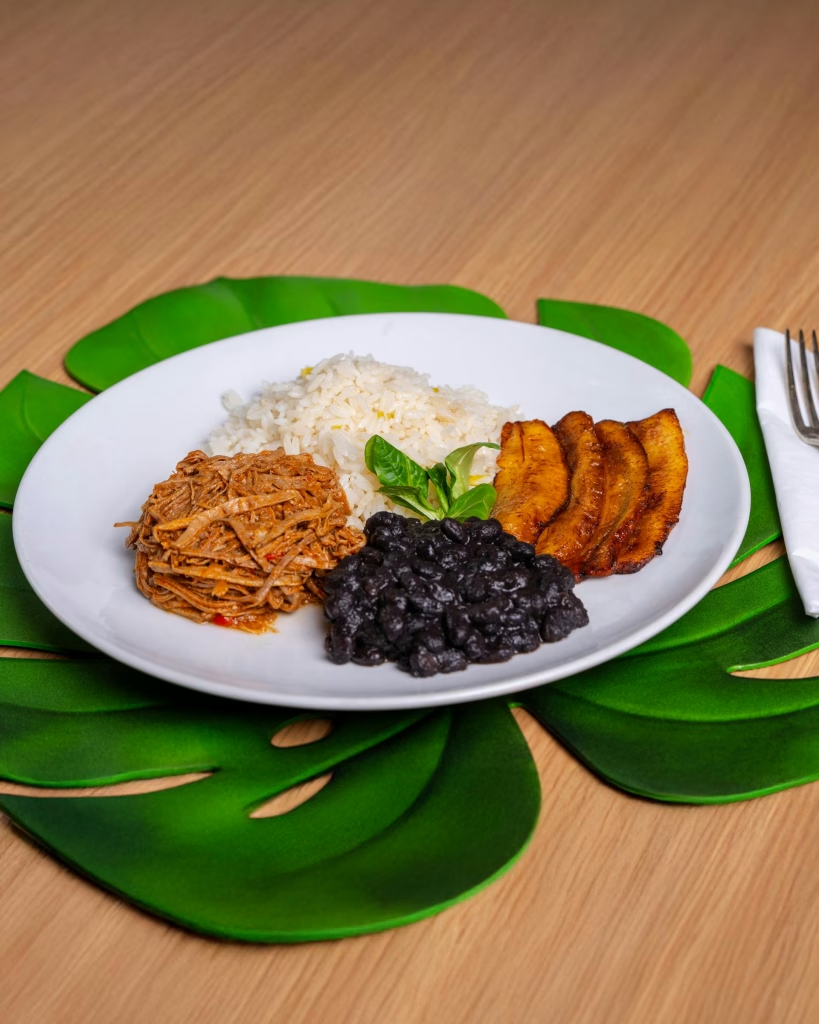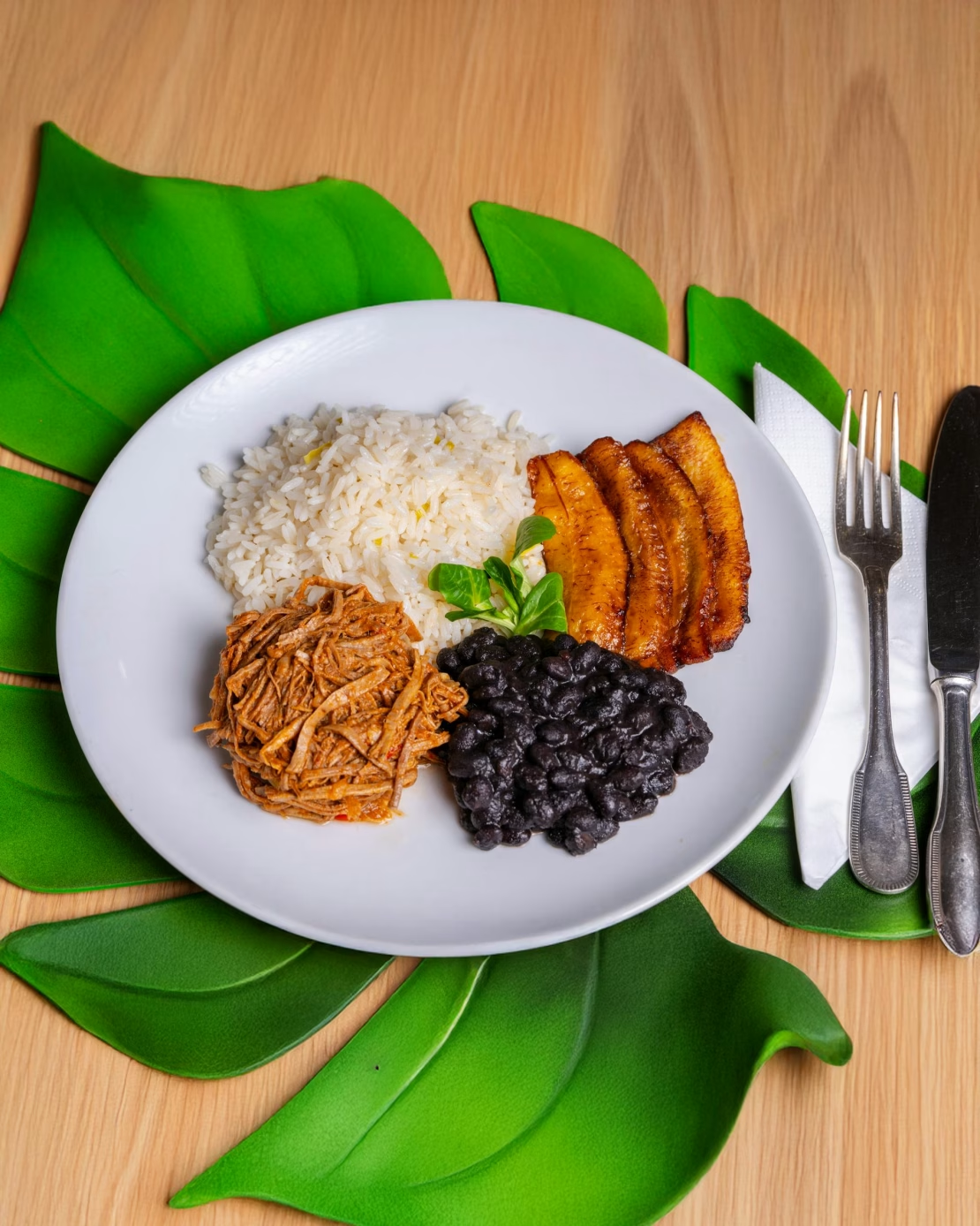Venezuelan Pabellón Criollo is the national dish of Venezuela, representing a colorful and flavorful reflection of the country’s multicultural roots.
This hearty meal is composed of shredded beef (carne mechada), stewed black beans (caraotas negras), white rice, and sweet fried plantains (tajadas). Each component brings a unique taste and texture—savory, creamy, starchy, and sweet—creating a perfect harmony on one plate.
Rich in history and tradition, this dish is a culinary celebration of Venezuelan heritage and is commonly enjoyed during family gatherings, festive events, and everyday meals.
Table of Contents
Ingredients
For the Carne Mechada (Shredded Beef):
- 1 ½ lbs flank steak or skirt steak
- 6 cups water (for boiling)
- 1 bay leaf
- 1 medium onion, chopped
- 1 bell pepper (red or green), chopped
- 2 garlic cloves, minced
- 1 large tomato, diced
- 2 tbsp tomato paste
- 1 tsp ground cumin
- ½ tsp smoked paprika
- 1 tsp oregano
- 1 tbsp Worcestershire sauce
- 2 tbsp vegetable oil
- Salt and pepper to taste
For the Caraotas Negras (Black Beans):
- 1 ½ cups dried black beans (or 2 cans, drained and rinsed)
- 6 cups water (for dried beans)
- 1 small onion, finely chopped
- 2 garlic cloves, minced
- ½ green bell pepper, chopped
- 1 tbsp sugar
- 1 tbsp vegetable oil
- Salt and pepper to taste
For the Rice:
- 2 cups white rice
- 4 cups water
- 1 tbsp oil
- 1 tsp salt
For the Tajadas (Sweet Fried Plantains):
- 2 ripe plantains (black-skinned)
- Vegetable oil for frying
- Pinch of salt (optional)
Serves
Serves 4–6 people
Step-by-Step Instructions
1. Prepare the Beef (Carne Mechada)
- Place the beef in a large pot with water and bay leaf. Boil for 1.5–2 hours until tender.
- Remove the beef and shred it using two forks.
- Reserve 1–2 cups of the broth.
- In a skillet, heat oil and sauté onion, garlic, and bell pepper for 5 minutes.
- Add tomato, tomato paste, Worcestershire sauce, cumin, paprika, and oregano. Stir well.
- Add shredded beef and reserved broth. Simmer for 10–15 minutes until flavors meld and the mixture thickens slightly. Season with salt and pepper.
2. Cook the Black Beans (Caraotas Negras)
- If using dried beans, soak overnight, then simmer in fresh water for 1.5–2 hours until tender.
- In a pan, heat oil and sauté onion, garlic, and bell pepper.
- Add cooked or canned beans, sugar, salt, and pepper.
- Simmer for 15–20 minutes to absorb the flavors. Mash a few beans for creaminess if desired.
3. Cook the White Rice
- Rinse rice until water runs clear.
- Bring water, salt, and oil to a boil. Add rice, stir once.
- Reduce heat, cover, and cook on low for 15 minutes.
- Fluff with a fork before serving.
4. Fry the Plantains (Tajadas)
- Peel ripe plantains and slice diagonally into ½-inch pieces.
- Heat oil in a frying pan over medium-high heat.
- Fry plantain slices in batches until golden brown on both sides.
- Remove and drain on paper towels. Sprinkle lightly with salt if desired.
5. Assemble the Pabellón Criollo
- On a large plate, arrange a portion of white rice, shredded beef, black beans, and sweet plantains.
- Serve hot with lime wedges or avocado slices if desired.

Serving Suggestions
- With Avocado: A few slices of ripe avocado add richness and balance.
- With Arepas: Serve with mini arepas on the side for a true Venezuelan experience.
- With Fried Egg: Top with a sunny-side-up egg for a popular variation called Pabellón a Caballo.
- Family-Style: Serve each component in separate bowls so guests can customize their plates.
- Holiday Style: Add fried yucca or cassava on the side during festive occasions.
Tips for Perfect Pabellón Criollo
- Shred the Beef Finely: The more finely shredded, the better it absorbs flavors.
- Use Ripe Plantains: The darker the skin, the sweeter and better the texture.
- Simmer the Beans Long Enough: Whether canned or dried, let them soak up the sautéed aromatics.
- Don’t Rush the Beef: Slow boiling ensures tenderness and rich broth.
- Batch Cook Components: Each part can be made ahead and assembled at mealtime.
Healthier Alternatives
- Lean Beef Cuts: Use leaner cuts like eye of round for less fat.
- Bake Plantains: Slice and bake at 400°F (200°C) for 20 minutes instead of frying.
- Brown Rice: Substitute with brown rice for extra fiber and nutrients.
- Vegetarian Version: Replace beef with jackfruit or mushrooms sautéed with the same spices.
- Low-Sodium: Cook beans from scratch and control added salt to reduce sodium intake.
Creative Variations
- Arepa Sandwich: Stuff all components inside an arepa for a portable meal.
- Tostones Version: Use tostones (green plantain fritters) instead of sweet plantains for a savory touch.
- Beefless Pabellón: Use grilled chicken or pulled pork for a twist.
- Spicy Twist: Add a touch of chili powder or hot sauce to the beef for heat.
- Pabellón Bowl: Serve all ingredients in a bowl with greens and avocado for a modern presentation.
Common Mistakes to Avoid
- Underseasoning the Beef: This is the heart of the dish—be generous with spices.
- Skipping Broth in the Filling: Reserved broth adds depth and keeps the beef juicy.
- Using Unripe Plantains: Green or yellow plantains won’t caramelize properly.
- Burning the Plantains: Watch the heat—medium is best to cook them evenly.
- Overcooking the Rice: Sticky rice can throw off the texture balance—keep it fluffy.
- Forgetting to Soak Beans: If using dried beans, soak overnight to speed up cooking.
- Not Mashing Beans: Slight mashing gives the black beans a richer texture.
- Cooking All Components Together: Cook separately for authentic flavor layering.
- Using Cheap Cuts of Beef: Flank or skirt steak works best for tenderness and shredding.
- Serving Cold: Serve hot or warm—each element should be freshly heated for the best experience.
History of Venezuelan Pabellón Criollo
The Pabellón Criollo has deep roots in Venezuela’s colonial era, evolving from the traditions of enslaved Africans, indigenous peoples, and Spanish settlers. It is believed that the dish was originally a way to repurpose leftover meats and beans, combining them with local staples like plantains and rice. Each component—rice from Asia, beef from Spanish cattle, beans from indigenous diets, and plantains from Africa—reflects a different cultural influence.
Over the centuries, the dish became standardized and revered as the national plate of Venezuela, particularly during the 20th century. It was seen as a symbol of unity, representing the coming together of Venezuela’s diverse peoples and traditions on one plate. The word “pabellón” means “flag” in Spanish, and the colorful array of components visually resembles the stripes of a national banner.
Today, Pabellón Criollo remains a treasured part of Venezuelan identity, eaten across all social classes and regions. Whether served at a humble family table or a gourmet restaurant, its importance transcends taste—it is history, culture, and comfort in every bite.
FAQs about Venezuelan Pabellón Criollo
1. What cut of beef is best for Pabellón Criollo?
Flank steak or skirt steak is traditional—they shred easily and are full of flavor.
2. Can I make Pabellón Criollo ahead of time?
Yes! Prepare each component ahead and reheat before serving.
3. Are plantains necessary?
Sweet fried plantains are essential for the classic version, but you can substitute tostones or omit them in a pinch.
4. Can I use canned beans?
Yes, canned black beans work well—just rinse and simmer with the sautéed aromatics.
5. Is Pabellón Criollo spicy?
No, it’s a well-seasoned but mild dish. You can add chili if desired.
6. Is this dish gluten-free?
Yes, all traditional ingredients are naturally gluten-free.
7. What does “a Caballo” mean in Pabellón a Caballo?
It means “on horseback”—referring to the fried egg served on top of the dish.
8. What’s the origin of the name “Pabellón Criollo”?
It refers to the “criollo” people (those of European descent born in Latin America) and the colorful plate resembling a flag (pabellón).
9. Can I make this dish vegetarian?
Yes! Substitute beef with jackfruit, tofu, or mushrooms sautéed with the same seasonings.
10. Can I serve it with something else besides rice?
Yes, quinoa or cauliflower rice can be used as low-carb alternatives.
Venezuelan Pabellón Criollo is more than just a meal—it’s a flavorful mosaic of Venezuela’s cultural and culinary heritage. With its tender shredded beef, savory black beans, fluffy rice, and sweet plantains, this dish offers a sensory journey through taste, texture, and tradition. Whether you’re preparing it for the first time or recreating a cherished family recipe, Pabellón Criollo is guaranteed to impress. It invites you to savor not just a national dish, but the story of a nation—one delicious bite at a time.


